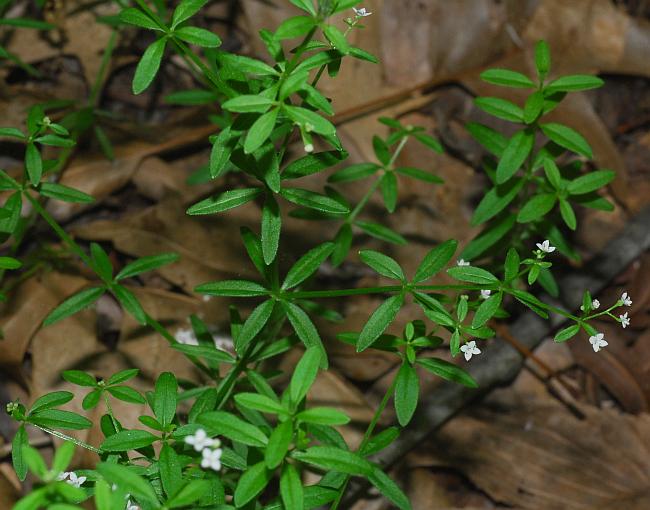Galium obtusum Bigelow
Blunt-Leaved Bedstraw

Native
CC = 5
CW = -3
MOC = 58
© SRTurner
Galium obtusum BigelowBlunt-Leaved Bedstraw | |
 |
Native CC = 5 CW = -3 MOC = 58 |
© SRTurner |
|
Family - Rubiaceae Habit - Perennial forb.
Stems - Spreading to weakly ascending, clambering on other vegetation, usually well-branched, 4-sided, glabrous or sparsely pubescent with minute to short, straight, spreading hairs, these mostly restricted to the nodes. Leaves - Whorled, usually 4 per node, usually spreading in orientation, simple, sessile, entire. Blades 5-23 mm long, 1-5 mm wide, narrowly elliptic, rounded or angled to a bluntly pointed tip, the midvein not extended into a point, angled or tapered at the base, the undersurface not glandular, glabrous or sparsely pubescent with minute to short, stout, stiff hairs along the midvein toward the base, the venation with only a single midvein visible, the margins glabrous or more commonly roughened with minute, ascending, spinelike outgrowths, usually somewhat curled under.
Inflorescence - Terminal and sometimes also axillary from the upper leaves, not pendent, positioned over the leaves, consisting of small (0.5-1.5 cm long), stalked clusters or less commonly panicles with 1 branchpoint, the branches, when present, loosely ascending.
Flowers - Mostly few to several, the stalks 1-6 mm long. Calyces essentially absent. Corollas 1.5-2.5 mm long, 4-lobed, white. Stamens 4, attached in the corolla tube, the anthers exserted. Style 2-lobed, the stigmas 2, capitate. Ovary glabrous, inferior, 2-locular, the ovules 1 per locule.
Fruits - Small, dry schizocarps 1.5-2.0 mm long, 3-4 mm wide, the surface glabrous, smooth, separating into two mericarps at maturity. Flowering - May - July. Habitat - Bottomland forests, swamps, sloughs, marshes, streambanks, fens, moist swales, ditches. Origin - Native to U.S. Lookalikes - Other species of Galium, especially G. tinctorium and G. circaezans. Other info. - This little species can be found throughout Missouri. Its U.S. distribution is primarily within the Midwest, although it ranges to the Atlantic coast and into New England. It is considered a noxious weed in a few northeastern states. The plant can be identified by its moist to wet habitat, small white flowers, glabrous stems and ovaries, and leaves which are usually 4 at a node. When left untouched, the plant can grow into large mats. Missouri plants are assignable to ssp. obtusum. The other subspecies, ssp. filifolium (Wiegand) Puff, has narrower leaves and occurs primarily in Virginia and the Carolinas. Photographs taken at Taberville Prairie, MO., 6-7-03 (DETenaglia); also at Otter Slough Conservation Area, Stoddard County, MO, 5-20-2014 and 5-14-2016 (SRTurner). |